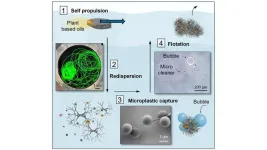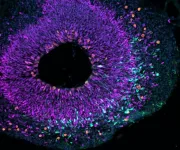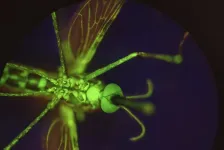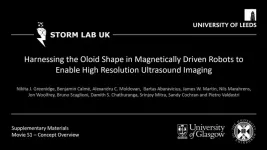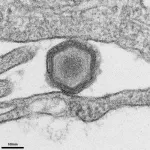(Press-News.org) FOR IMMEDIATE RELEASE
March 26, 2025
BATON ROUGE – Scientists at Pennington Biomedical Research Center have gained greater clarity in the brain regions and neurons that control metabolism, body temperature and energy use. Featured in the February edition of the journal Metabolism, Dr. Heike Münzberg-Gruening and a team of researchers discovered which chemicals influence the signals that control how much energy the body uses. In “Leptin Receptor Neurons in the dorsomedial hypothalamus require distinct neuronal subsets for thermogenesis and weight loss,” researchers laid out the pathways, chemicals, neurons and brain regions that are activated.
In previous research, Dr. Münzberg-Gruening and her team identified that leptin receptors, or Lepr, control the metabolic effects of Leptin. These receptors are neurons in the dorsomedial hypothalamus, or DMH, which is a nucleus located in the hypothalamus at the base of the brain. In their latest study, researchers found that these Lepr neurons communicate using two different chemical signals: glutamate, which excites neurons, or GABA, which calms neurons.
The study revealed that the neurons that send signals to the brain region called the raphe pallidus - a region that controls metabolism - only use glutamate to send their signals. The neurons that signal to another brain region – the arcuate nucleus, which regulate body weight, satiety and metabolism – use only GABA. These neurons also have special receptors that allow them to respond to the new weight-loss medications known as GLP-1 receptor agonists.
“This discovery sheds light on the fundamental neuronal interplay that influences how much energy the body uses and how the body adjusts to changes in temperature levels or food availability,” said Dr. Münzberg, professor in Pennington Biomedical’s Central Leptin Signaling Lab. “This research expands our knowledge of the circuitry of thermoregulation and emphasizes the unique capability of leptin signaling in the DMH to promote beneficial metabolic effects. It also clarifies leptin signaling’s role in the stability of body weight and energy usage. We believe these neurons manage the body’s ability to adapt to a variety of environmental changes like ambient temperature or food scarcity by integrating signals like leptin and the gut hormone glucagon-like-peptide-1 or GLP-1.”
In addition to identifying which neurons from the DMH affect certain regions and their functions, researchers further found that some Lepr neurons are muted by leptin, while others were activated specifically when certain indirect signals were blocked. This suggests that the DMH is part of a larger neuronal network and leptin increases the muting effect of outside connections with the DMH, but when these outside connections are blocked, leptin is able to un-mute DMH neurons. Such networks may be relevant to integrate and, if necessary, override environmental and humoral signals to allow proper adaptation of body energy balance.
This study further clarifies that Lepr neurons are a unique selection of DMH neurons that promote metabolic benefits. They might also explain the paradox that robust weight loss with GLP-1-based medications is able to override the slow metabolism usually associated with weight loss, but this paradox needs to be further tested in future studies.
“There are still so many fundamental processes in our bodies and brains that remain a mystery to us, and that's exactly what drives our researchers at Pennington Biomedical —to explore these unknowns, make new discoveries and deepen our understanding of metabolism,” said Dr. John Kirwan, Executive Director of Pennington Biomedical Research Center. “I want to congratulate Dr. Münzberg and her team on this exciting discovery. It really showcases the incredible work that is happening in our Pre-Clinical Basic Science labs, and I can’t wait to see what they’ll discover next.”
About the Pennington Biomedical Research Center
The Pennington Biomedical Research Center is at the forefront of medical discovery as it relates to understanding the triggers of obesity, diabetes, cardiovascular disease, cancer and dementia. Pennington Biomedical has the vision to lead the world in promoting metabolic health and eliminating metabolic disease through scientific discoveries that create solutions from cells to society. The center conducts basic, clinical, and population research, and is a campus in the LSU System.
The research enterprise at Pennington Biomedical includes over 600 employees within a network of 44 clinics and research laboratories, and 13 highly specialized core service facilities. Its scientists and physician/scientists are supported by research trainees, lab technicians, nurses, dietitians, and other support personnel. Pennington Biomedical is a globally recognized state-of-the-art research institution in Baton Rouge, Louisiana.
For more information, see www.pbrc.edu.
-30-
Media Contacts:
Joe Coussan
Pennington Biomedical Research Center
225-763-3049
Joe.coussan@pbrc.edu
Ernie Ballard
Pennington Biomedical Research Center
225-763-2677
Ernie.ballard@pbrc.edu
END
Pennington Biomedical researchers identify neurons in brain that regulate energy levels and body temperature
Research shows that the brain area that helps control body temperature, energy use and eating habits uses specific chemical and neuronic pathways to influence regulating adjustments
2025-03-26
ELSE PRESS RELEASES FROM THIS DATE:
Cleaning microplastics
2025-03-26
In a new paper, researchers at North Carolina State University show proof of concept for a system that, in a single cycle, actively removes microplastics from water.
The findings, described in the journal Advanced Functional Materials, hold the potential for advances in cleansing oceans and other bodies of water of tiny plastics that may harm human health and the environment.
“The idea behind this work is: Can we make the cleaning materials in the form of soft particles that self-disperse in water, capture microplastics as they sink, and then return to the surface with the captured microplastic contaminants?” said Orlin Velev, the S. Frank and Doris Culberson Distinguished ...
MD Anderson names Jeffrey E. Lee, M.D., Chief Medical Executive
2025-03-26
HOUSTON ― The University of Texas MD Anderson Cancer Center today announced that Jeffrey E. Lee, M.D., an internationally regarded leader in the field of oncology, has been appointed chief medical executive (CME) effective April 1.
Prior to his appointment, Lee served as CME ad interim, demonstrating strength as a leader committed to advancing the institution’s efforts in research, patient care, prevention and education. Assuming the role of CME is the culmination of Lee’s 34-year tenure at the institution, where he has made substantial contributions in the field ...
Sensor technology uses nature’s blueprint and machinery to monitor metabolism in body
2025-03-26
Life’s essential functions are powered by a set of compounds called metabolites, which are involved in every natural process including producing energy, regulating cell activity and keeping the body’s systems in balance. Tracking these molecules offers a window into the onset and status of many diseases, overall health, response to treatment and the intricate workings of biological systems.
However, today’s metabolite sensing methods fall short. Most rely on resource-intensive lab tests that give only brief snapshots from isolated samples. The few sensors that can track metabolites continuously are largely limited to detecting blood sugar.
An interdisciplinary ...
Chan Zuckerberg Initiative announces new biohub to develop breakthrough imaging technologies to observe cells in action
2025-03-26
REDWOOD CITY, Calif. (March 26, 2025) — The Chan Zuckerberg Initiative (CZI) announced a new grand challenge to develop groundbreaking imaging technologies to transform how scientists observe, measure and understand living cells and organisms. CZI’s two powerhouse institutes, CZ Biohub San Francisco and CZ Institute for Advanced Biological Imaging, will leverage their complementary expertise to form a new Biohub unmatched in the field of life science imaging research. They will combine their teams at a new science campus in Redwood City, Calif., adjacent to CZI ...
Encryption breakthrough lays groundwork for privacy-preserving AI models
2025-03-26
In an era where data privacy concerns loom large, a new approach in artificial intelligence (AI) could reshape how sensitive information is processed.
Researchers Austin Ebel and Karthik Garimella, Ph.D students, and Assistant Professor of Electrical and Computer Engineering Brandon Reagen have introduced Orion, a novel framework that brings fully homomorphic encryption (FHE) to deep learning — allowing AI models to practically and efficiently operate directly on encrypted data without needing to decrypt it first.
The implications of this advancement, ...
Top global award for young technologists goes to researcher who advanced AI with high-performance computers
2025-03-26
ACM, the Association for Computing Machinery, today named Torsten Hoefler, a Professor at ETH Zurich, the recipient of the 2024 ACM Prize in Computing for fundamental contributions to high-performance computing and the ongoing AI revolution. Hoefler developed many of the core capabilities of modern supercomputers and defined key aspects of the algorithms for distributing AI models on them.
The ACM Prize in Computing recognizes early-to-mid-career computer scientists whose research contributions have fundamental impact and broad implications. ...
How did the large brain evolve?
2025-03-26
The results of the study show that the two genes act in a finely tuned interplay: one ensures that the progenitor cells of the brain multiply more, while the other causes these cells to transform into a different type of progenitor cell - the cells that later form the nerve cells of the brain. In the course of evolution, this interplay has led to the human brain being unique in its size and complexity.
The newly gained insights not only provide a deeper understanding of the evolutionary development of our brain but could also help to better comprehend how certain developmental disorders or diseases of the brain arise. ‘Our findings deepen the fundamental ...
Rare disease drug nitisinone makes human blood deadly to mosquitoes
2025-03-26
In the fight against malaria, controlling the mosquito population is crucial.
Several methods are currently used to reduce mosquito numbers and malaria risk. One of these includes the antiparasitic medication ivermectin. When mosquitoes ingest blood containing ivermectin, it shortens the insect’s lifespan and helps decrease the spread of malaria.
However, ivermectin has its own issues. Not only is it environmentally toxic, but also, when it is overused to treat people and animals with worm ...
Mini rolling robot takes virtual biopsies
2025-03-26
Embargoed: Not for Release Until 2pm U.S. Eastern Time (6pm GMT) Wednesday, 26 March 2025
With images and videos
A tiny magnetic robot which can take 3D scans from deep within the body, that could revolutionise early cancer detection, has been developed by researchers.
The team, led by engineers from the University of Leeds, say this is the first time it has been possible to generate high-resolution three-dimensional ultrasound images taken from a probe deep inside the gastrointestinal ...
Researchers design tools to develop vaccines more efficiently for African swine fever virus (ASFV)
2025-03-26
Rockville, Maryland—March 26, 2024—Researchers from the J. Craig Venter Institute (JCVI), the Friedrich-Loeffler-Institut (FLI), and the International Livestock Research Institute (ILRI) have developed a reverse genetics system for African swine fever virus (ASFV). This new system will aid researchers in developing vaccines and in studying the pathogenesis and biology of ASFV, a highly contagious, deadly viral disease affecting domesticated and wild pigs, especially prevalent in Africa, Europe, Asia, and the Caribbean. A recent study estimates if ASFV reached the United States it could result ...
LAST 30 PRESS RELEASES:
Making lighter work of calculating fluid and heat flow
Normalizing blood sugar can halve heart attack risk
Lowering blood sugar cuts heart attack risk in people with prediabetes
Study links genetic variants to risk of blinding eye disease in premature infants
Non-opioid ‘pain sponge’ therapy halts cartilage degeneration and relieves chronic pain
AI can pick up cultural values by mimicking how kids learn
China’s ecological redlines offer fast track to 30 x 30 global conservation goal
Invisible indoor threats: emerging household contaminants and their growing risks to human health
Adding antibody treatment to chemo boosts outcomes for children with rare cancer
Germline pathogenic variants among women without a history of breast cancer
Tanning beds triple melanoma risk, potentially causing broad DNA damage
Unique bond identified as key to viral infection speed
Indoor tanning makes youthful skin much older on a genetic level
Mouse model sheds new light on the causes and potential solutions to human GI problems linked to muscular dystrophy
The Journal of Nuclear Medicine ahead-of-print tip sheet: December 12, 2025
Smarter tools for peering into the microscopic world
Applications open for funding to conduct research in the Kinsey Institute archives
Global measure underestimates the severity of food insecurity
Child survivors of critical illness are missing out on timely follow up care
Risk-based vs annual breast cancer screening / the WISDOM randomized clinical trial
University of Toronto launches Electric Vehicle Innovation Ontario to accelerate advanced EV technologies and build Canada’s innovation advantage
Early relapse predicts poor outcomes in aggressive blood cancer
American College of Lifestyle Medicine applauds two CMS models aligned with lifestyle medicine practice and reimbursement
Clinical trial finds cannabis use not a barrier to quitting nicotine vaping
Supplemental nutrition assistance program policies and food insecurity
Switching immune cells to “night mode” could limit damage after a heart attack, study suggests
URI-based Global RIghts Project report spotlights continued troubling trends in worldwide inhumane treatment
Neutrophils are less aggressive at night, explaining why nighttime heart attacks cause less damage than daytime events
Menopausal hormone therapy may not pose breast cancer risk for women with BRCA mutations
Mobile health tool may improve quality of life for adolescent and young adult breast cancer survivors
[Press-News.org] Pennington Biomedical researchers identify neurons in brain that regulate energy levels and body temperatureResearch shows that the brain area that helps control body temperature, energy use and eating habits uses specific chemical and neuronic pathways to influence regulating adjustments
